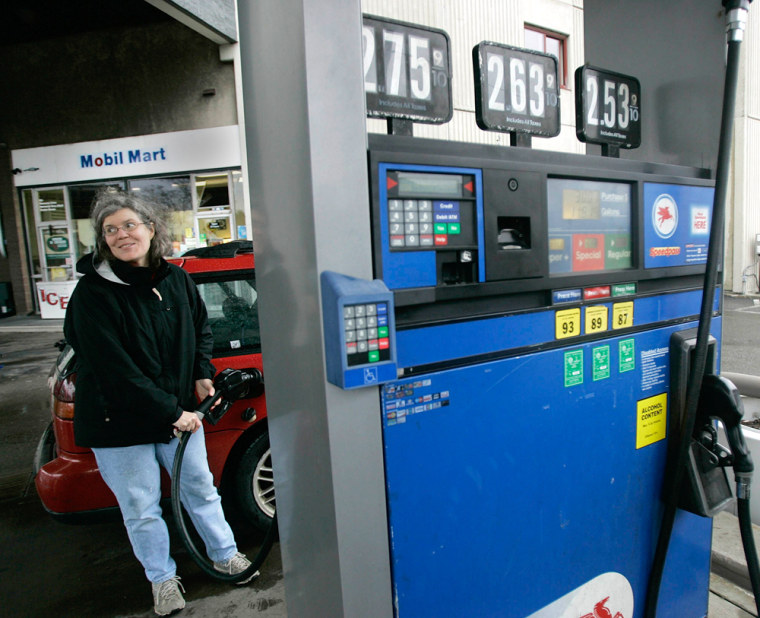Elementary school principal Randy Busscher of Holland, Mich., is braced for gasoline prices of $3 a gallon or more by summer break.
Analysts say Busscher and other U.S. motorists may be more worried than necessary, however. Absent a major Gulf Coast hurricane, unexpected international strife or a wave of refinery woes, average U.S. gasoline prices are not expected to rise to the $3-a-gallon psychological threshold this summer — a good sign as well for the broader economy, which is under pressure from a weakening housing market.
When energy prices rise, the risk is that consumer spending will fall, particularly at discount stores and low-priced restaurants, whose customers tend to be more sensitive to extra costs in their monthly budgets.
The stock prices of some restaurant chains, including Applebee’s International Inc., Darden Restaurants Inc. and Wendy’s International Inc. dipped in recent weeks as gasoline prices rose. The Dow Jones Index for restaurants and bars is down more than 5 percent for the month, compared with a 4.7 percent decline for the benchmark Standard & Poor’s 500 index.
Energy analysts say U.S. gasoline supplies should be ample enough this summer to keep prices relatively stable. “We don’t think that oil prices are going to be a drag on the economy this summer,” said Global Insight energy analyst Kevin Lindemer.
Economist Douglas Porter of BMO Capital Markets in Toronto said consumer spending seems more likely to be hurt this summer by the slowdown in the housing market than any nominal increase in energy prices.
Still, the average price for regular unleaded has shot up nearly 40 cents per gallon since late January and Busscher, who drives a fuel-efficient Toyota Camry, is prepared for the worst. Seeing gasoline rise to last summer’s levels, when prices averaged more than $3 a gallon for much of July and August, “would bother me and I’m sure it would bother others.”

The national average price for regular unleaded climbed for the seventh straight week to an average of about $2.58 a gallon nationwide, according to a government report released Monday.
The Energy Information Administration, the Energy Department’s statistical agency, projects the average pump price of regular unleaded will hit a peak of around $2.70 a gallon in June, then drop off as the summer driving season wanes. The average price of crude oil is projected to remain around $64 per barrel through summer, down from last year’s record levels of more than $78 a barrel.
Gasoline prices have risen in recent weeks due to planned and unplanned refinery outages, as well as falling imports from Europe, according to the forecasting agency. Those conditions are expected to ease later this spring.
And unlike the start of last summer, when much of the country made a transition to ethanol as a gasoline-blending component, there should be ample supplies of the corn-based fuel this year, said Tom Kloza, chief oil analyst for Oil Price Information Service.
Other economists disagree.
Wachovia Corp. economists predict gasoline prices this summer will average $2.75 to $3 per gallon — lower than last year, but not by much.
“This year consumers have not only to contend with high gas prices, they’ve got to contend with worries about slowing economic growth,” said Wachovia economist Gina Martin. “The job market is still steady but not running as quickly as it was last year.”
The Organization of Petroleum Exporting Countries said in Vienna on Thursday that it plans to keep crude-oil production at existing levels, satisfied that two recent rounds of output cutbacks helped balance global markets and stabilize prices around $60 a barrel.
OPEC warned, though, that oil price volatility is likely to continue in 2007. Prices have zigzagged recently, sometimes sharply during the same day, buoyed by political tensions with Iran and pulled down by mild winter temperatures in the Northeast.
For many consumers, though, explanations of international turmoil that sends oil markets up and down are hardly reassuring. Warehouse worker Luis Ortega, 35, who commutes 80 miles a day to his job in southern California, has felt the impact of higher pump prices in recent weeks.
“I can’t go to the movies as often, dinner as often. I drive less and stay home more, watch more TV,” he said, filling up his red 1998 Toyota SUV with regular unleaded priced at $3.09 a gallon near downtown Los Angeles.
And as housing prices stall, consumers are no longer able to pull equity out of their homes with mortgage refinancings — hurting sales of things like refrigerators and flat-screen TVs, said BMO Capital Markets’ Porter. Compared with the impact of the housing market slump, recent increases in energy prices are not as much of a reason for concern, he added.
James Reed, 62, of Brookline, Mass., said falling home prices worry him much more than gasoline prices because, in the housing market “you are dealing with tens of thousands of dollars, whereas here you are dealing with $10 a week or $5 a week” to buy gasoline.
